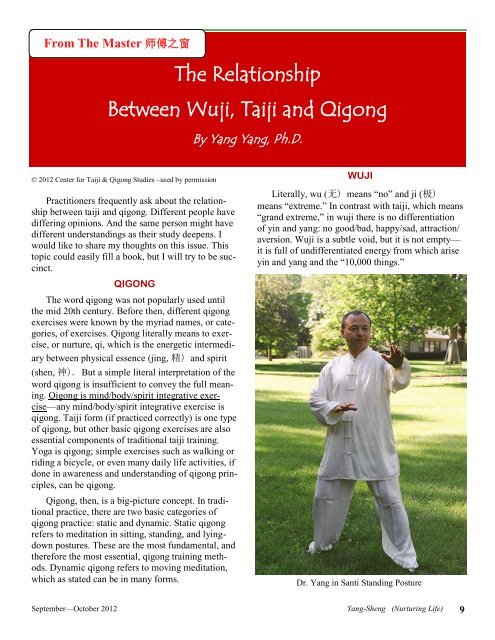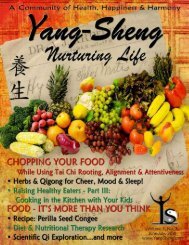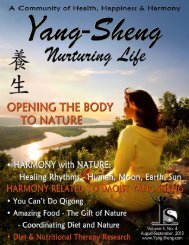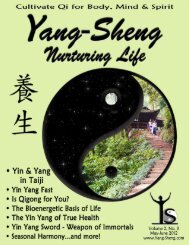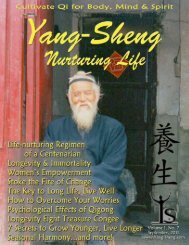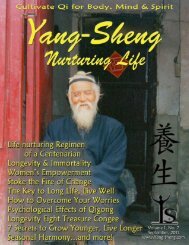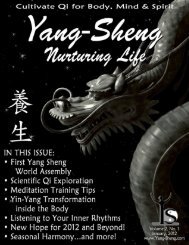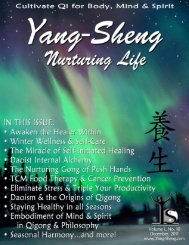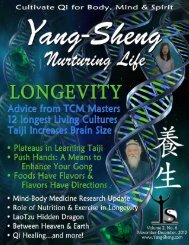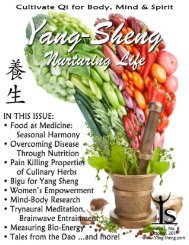Download - Yang-Sheng
Download - Yang-Sheng
Download - Yang-Sheng
Create successful ePaper yourself
Turn your PDF publications into a flip-book with our unique Google optimized e-Paper software.
From The Master 师 傅 之 窗<br />
The Relationship<br />
Between Wuji, Taiji and Qigong<br />
By <strong>Yang</strong> <strong>Yang</strong>, Ph.D.<br />
© 2012 Center for Taiji & Qigong Studies –used by permission<br />
Practitioners frequently ask about the relationship<br />
between taiji and qigong. Different people have<br />
differing opinions. And the same person might have<br />
different understandings as their study deepens. I<br />
would like to share my thoughts on this issue. This<br />
topic could easily fill a book, but I will try to be succinct.<br />
QIGONG<br />
The word qigong was not popularly used until<br />
the mid 20th century. Before then, different qigong<br />
exercises were known by the myriad names, or categories,<br />
of exercises. Qigong literally means to exercise,<br />
or nurture, qi, which is the energetic intermediary<br />
between physical essence (jing, 精 ) and spirit<br />
(shen, 神 ). But a simple literal interpretation of the<br />
word qigong is insufficient to convey the full meaning.<br />
Qigong is mind/body/spirit integrative exercise—any<br />
mind/body/spirit integrative exercise is<br />
qigong. Taiji form (if practiced correctly) is one type<br />
of qigong, but other basic qigong exercises are also<br />
essential components of traditional taiji training.<br />
Yoga is qigong; simple exercises such as walking or<br />
riding a bicycle, or even many daily life activities, if<br />
done in awareness and understanding of qigong principles,<br />
can be qigong.<br />
Qigong, then, is a big-picture concept. In traditional<br />
practice, there are two basic categories of<br />
qigong practice: static and dynamic. Static qigong<br />
refers to meditation in sitting, standing, and lyingdown<br />
postures. These are the most fundamental, and<br />
therefore the most essential, qigong training methods.<br />
Dynamic qigong refers to moving meditation,<br />
which as stated can be in many forms.<br />
WUJI<br />
Literally, wu ( 无 ) means “no” and ji ( 极 )<br />
means “extreme.” In contrast with taiji, which means<br />
“grand extreme,” in wuji there is no differentiation<br />
of yin and yang: no good/bad, happy/sad, attraction/<br />
aversion. Wuji is a subtle void, but it is not empty—<br />
it is full of undifferentiated energy from which arise<br />
yin and yang and the “10,000 things.”<br />
Dr. <strong>Yang</strong> in Santi Standing Posture<br />
September—October 2012 <strong>Yang</strong>-<strong>Sheng</strong> (Nurturing Life) 9


